If you're looking for breathtaking views of the cosmos, astrophotography is the way to go. This hobby combines the wonders of the universe with the art of photography. However, to capture stunning images of distant stars and galaxies, it is important to consider the focal length of your camera lens.
Focal length is the distance between the lens and the point where light is focused onto the camera's sensor. In astrophotography, choosing the right focal length is crucial to capture the details of celestial objects. A longer focal length produces a narrower field of view, resulting in more detailed images of a single object. On the other hand, a shorter focal length allows you to capture a wider field of view, making it perfect for capturing multiple objects in a single shot.
Are you wondering how to determine the perfect focal length for your astrophotography gear? What factors should you consider before making a purchase? Which lens is best suited for your camera? Stay tuned, as we answer all your questions in this comprehensive guide to focal length for astrophotography. We will delve into the technical aspects of focal length, explore different types of lenses available, and provide tips on how you can get the best out of your gear. So, grab your camera and let's start exploring the wonders of astrophotography!
10 Best Focal Length For Astrophotography
| # | Product Image | Product Name | Product Notes | Check Price |
|---|---|---|---|---|
|
1
|
Ideal for viewing distant objects in the night sky and capturing photos of those objects.
|
|
||
|
2
|
The product is ideal for adults interested in astronomy, as it comes with a telescope, smartphone adapter, and moon filter.
|
|
||
|
3
|
This product is ideal for adults, kids, and beginners interested in astronomy, equipped with an EQ mount, eyepieces, and smartphone adapter.
|
|
||
|
4
|
The product is ideal for adults who want to observe the night sky using a refractor telescope with a phone mount.
|
|
||
|
5
|
It's ideal for astrophotography with refractor or reflector telescopes, allowing either prime-focus or eyepiece-projection. It's threaded for standard astronomy filters.
|
|
||
|
6
|
The product is ideal for stargazers and astronomers, offering computerized controls and a portable design for ease of use.
|
|
||
|
7
|
The product is ideal for beginners interested in astronomy and is portable with a phone adapter and wireless remote.
|
|
||
|
8
|
The product is ideal for beginners in astronomy who require a telescope with a 1000mm focal length and 70mm objective lens.
|
|
||
|
9
|
This product is ideal for capturing high-quality night-time photography, time-lapse and panoramic shots with a Wi-Fi app camera control.
|
|
||
|
10
|
The product is ideal for viewing celestial objects and star gazing.
|
|
1. Sv503 Astrophotography Telescope: Exceptional Views, Compact Design
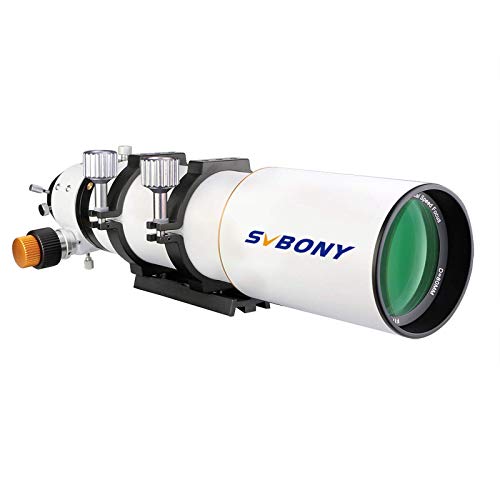
The SV503 Telescope OTA incorporates Extra-low Dispersion glass, making it ideal for providing crystal clear images. With its 80ED telescope, the SV503 produces high contrast and true-color images, perfect for discerning observers. Achieving accurate focus is made easy with the dual-speed rack and pinion focuser, which has a gear ratio of 1:10. The OTA is crafted using top-quality materials and features a beautiful, fine-grained paint finish. The optical surfaces are all multi-coated, providing exceptional views day or night. The telescope is perfect for astronomy enthusiasts, especially those interested in astrophotography.
- Incorporates Extra-low Dispersion glass for crystal clear images
- 80ED telescope produces color-true and high-contrast images
- Dual-speed rack and pinion focuser with 1:10 gear ratio for accurate focus
- Crafted using top-quality materials for durability and exquisite appearance
- Optical surfaces are all multi-coated for exceptional viewing experiences
- Ideal for astronomy enthusiasts, particularly those interested in astrophotography
2. Prosky Newtonian Telescope Kit
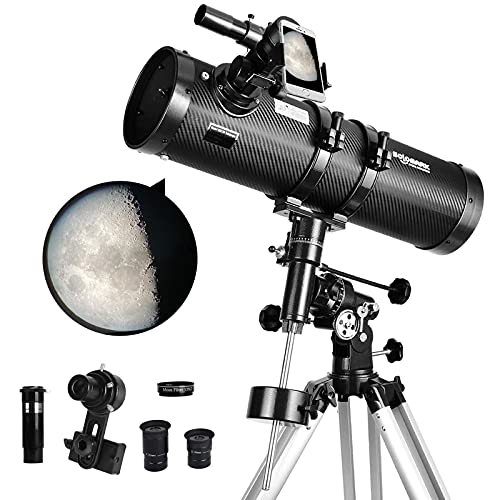
The large aperture of 130mm makes this telescope perfect for observing deep space celestial objects. It has high resolution and good light collecting ability, allowing for brighter and more detailed images. The telescope boasts a sturdy and light frame structure, covered with carbon fiber, and features fully-coated glass optics that improve its performance. The German equatorial mount comes with dial and fine-turned control cables, which enable precise positioning and fast tracking of celestial bodies, ensuring stable and accurate observations. The tripod is made of high-quality aluminum alloy and has a stable structure, making it easy to locate celestial objects smoothly. Moreover, this telescope comes with multiple accessories, including 2 high-quality eyepieces, a 1.5X erecting Barlow lens, a 1.25' 13% transmission moon filter, and a cellphone adapter. With all these features, you can enjoy observing the moon and planets with ease. If you have any questions, the friendly customer service team is available 24/7 to assist you.
- Large aperture of 130mm for observing deep space celestial objects
- Sturdy and light frame structure covered with carbon fiber
- Fully-coated glass optics that improve performance
- German equatorial mount with dial and fine-turned control cables for precise positioning and fast tracking of celestial bodies
- High-quality aluminum alloy tripod with a stable structure
- Multiple accessories included for ease of use
- Friendly customer service available 24/7 to assist you
3. Prostargaze: Astronomy Telescope With Eq Mount & Smartphone Adapter
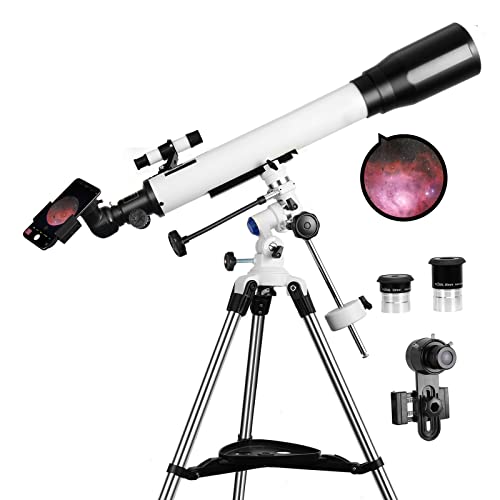
This versatile telescope can be used for both terrestrial and astronomical viewing, providing high-quality images with its fully multi-coated optics glass lens that has high transmission coatings to protect your eyes. It features erect image optics for easy use, making it a great option for kids and adults alike.
With a 70mm aperture and 700mm focal length, this telescope provides a magnification of 70X and 35X thanks to its 10mm and 20mm Plossl eyepieces. These eyepieces have better optical performance than K and H eyepieces, effectively reducing chromatic aberration and halo for clearer images.
Equipped with an equatorial mount type, this telescope comes with two slow motion control cables that allow for fine pointing adjustments in both R.A. and Declination. The mount is sturdy and durable, providing stability for the telescope.
Setting up the telescope is quick and easy, with no tools required. The telescope comes with a full size stainless steel adjustable tripod that can be set to any height and angle, providing a stable and safe platform for viewing. Additionally, a smartphone adapter with 1.5X Barlow Lens is included, which provides 70x magnification and allows you to capture and share images and videos with ease.
- Suitable for both terrestrial and astronomical viewing
- Fully multi-coated optics glass lens with high transmission coatings for high-quality images
- Equatorial mount type with slow motion control cables for fine adjustments
- No-tool setup for quick and easy installation
- Comes with a smartphone adapter and tripod for stable viewing and image capturing
4. Stargaze Pro: Boblov Refractor Telescope With Accessories
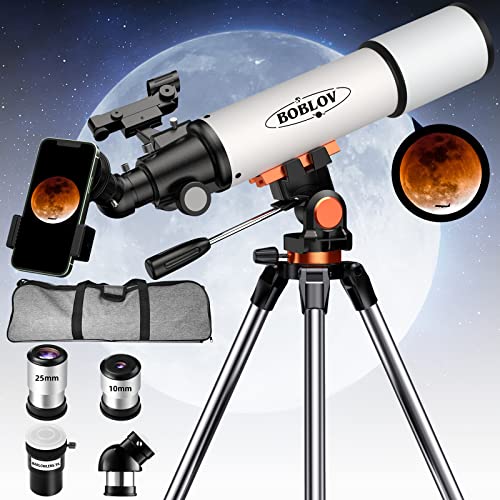
The BOBLOV Astronomical Refractor is a professional-grade telescope that comes with a full-coated optical lens and a 45-degree zenith mirror, which offer higher transmission rates and a wider field of view for comfortable observation. With two replaceable eyepieces (K20mm and K10mm) and a 3x Barlow lens, this telescope can magnify the moon up to 120 or 240 times, creating stunning images with increased brightness and clarity. It has a focal length of 500MM and an 80MM large aperture of the objective lens, which provides clearer images of the moon.
Equipped with a high-quality stainless steel tripod, this telescope is sturdy and stable, with a maximum height of 45 inches. The adjustable knob and handle make it easy to intuitively and accurately position the celestial body. The telescope comes with a bag, which makes it easy to carry around.
This telescope is perfect for kids who are curious about the moon. It can show them the potholes and moon hills, helping families have fun and build great memories through play. The BOBLOV Astronomical Telescope has a 5×24 infrared optical viewfinder with a laser red transmitter. Switch it on, and adjust the direction calibration knob and replaceable CR2 battery to find the star, easy to focus and install.
The BOBLOV telescope is an affordable and powerful refractor telescope that is perfect for adults and kids as a birthday or holiday gift. It comes with a smartphone adapter that allows you to capture and record beautiful images of the moon. Simply touch your phone's screen, and you can take a celestial picture and share your excitement with friends and family in real-time. The sturdy handbag makes it perfect for travel.
- Full coated optical lens and 45-degree zenith mirror for higher transmission rates and a wider field of view
- Two replaceable eyepieces and a 3x Barlow lens for magnifying the moon up to 120 or 240 times
- Sturdy and stable stainless steel tripod with a maximum height of 45 inches
- 5×24 infrared optical viewfinder with a laser red transmitter for finding stars
- Comes with a smartphone adapter and a sturdy handbag for travel
5. Extendable Camera Adapter For Astromania Telescopes
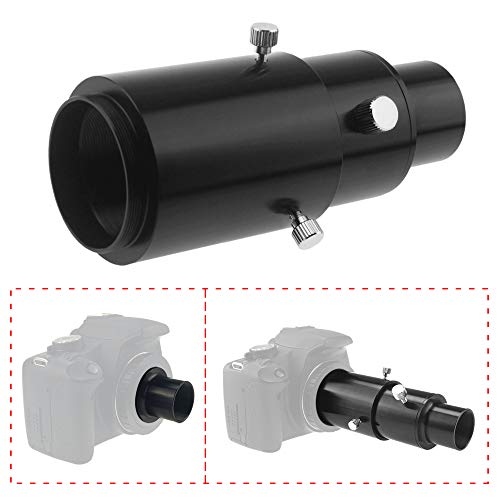
Take your astrophotography to the next level with this versatile projection and focal adapter. It is designed to work with standard Ploessl or Kellner 1.25-inch eyepieces for capturing stunning photos of the Moon and planets. The adapter is easy to use and attaches both camera body and telescope together, making it compatible with both reflector and refractor telescopes with 1.25" eyepiece holders.
This dual design adapter allows the user to make slight magnification adjustments without the need to change telescope eyepieces. It is made of black-anodized aluminum and threaded for standard 1.25-inch astronomy filters. The projection adapter is suitable for 1.25-inch eyepieces of up to 38mm outside diameter and can also be used as a focal adapter with a T2 thread.
The projection and focal adapter consists of two parts – the projection part and the focal adapter. The projection part is used with an eyepiece to achieve a long focal length for small objects, such as individual craters. Use the focal adapter without the eyepiece to take photos of the entire Moon, gas nebula, or galaxy – employing the focal length of your telescope.
The sliding rear part of the adapter allows you to zoom in and out without changing your eyepiece. You can use an eyepiece of any focal length and achieve high-magnification images of lunar craters and planets. All you need is a T2 ring (not included) and a suitable camera with a bayonet connector.
- Compatible with both reflector and refractor telescopes with 1.25" eyepiece holders
- Made of black-anodized aluminum and threaded for standard 1.25-inch astronomy filters
- Dual design allows for slight magnification adjustments without changing telescope eyepieces
- Zoom in and out without changing your eyepiece
- – T2 ring not included
6. Nexstar 130slt: Portable Skyalign Telescope
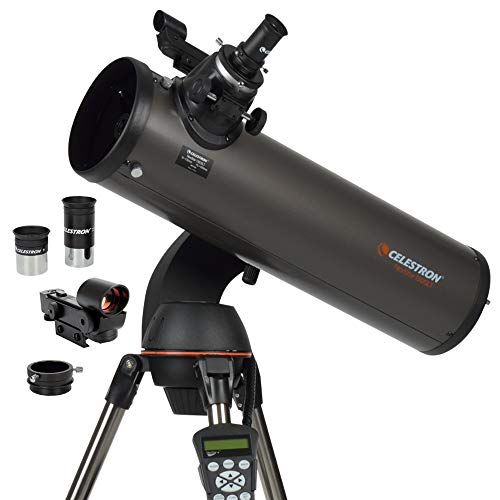
The Celestron NexStar 130SLT is a computerized star locating telescope that offers a database of more than 40,000 stars, galaxies, nebulae, and more. It is designed to simplify stargazing by automatically locating and tracking celestial objects with ease. Its Newtonian reflector optical design features a large 130mm aperture that allows users to view our Solar System and beyond in brilliant detail. From Saturn's rings and Jupiter's cloud bands to the Moon's craters and the Orion Nebula, the NexStar 130SLT is capable of gathering enough light to reveal these celestial wonders.
This telescope is compact, lightweight, and portable, making it an ideal choice for both adults and kids to use together. Whether you're at your favorite campsite, a dark sky observing site, or simply in your backyard, you can easily transport the NexStar 130SLT to any location. Setting up the telescope is quick and effortless with Celestron's proprietary SkyAlign procedure. Simply center any three bright objects in the eyepiece, and the NexStar SLT will align to the night sky, ready to locate thousands of objects.
Buying the Celestron NexStar 130SLT from an authorized dealer on Amazon gives you a 2-year US warranty and unlimited support from the team of US-based experts at Celestron. This telescope also comes with a bonus free download of Starry Night Special Edition, one of the top-rated astronomy software programs that allows users to simulate the sky, learn about celestial objects, and plan observing sessions.
- Database of more than 40,000 stars, galaxies, nebulae, and more
- Newtonian reflector optical design with large 130mm aperture for brilliant detail
- Compact, lightweight, and portable for easy transport
- Quick and effortless setup with Celestron's proprietary SkyAlign procedure
- 2-year US warranty and unlimited support from Celestron's team of US-based experts
- Bonus free download of Starry Night Special Edition software program
7. Skyexplorer Telescope: Astronomy Fun For All Ages!
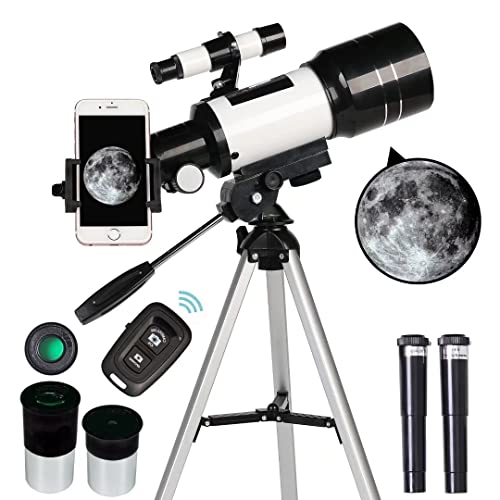
Introduce the wonders of the universe to kids and beginners with this amazing telescope! Equipped with 3X Barlow lens and two eyepieces, H20mm and H6mm, this telescope provides a magnification of 15X to 150X, making it a great tool for adults and kids alike. The 70mm aperture and 300mm focal length of the telescope provide clear and bright images, even for beginners. With the wireless control feature, you can easily connect your smartphone to the eyepieces and take amazing images of the stars and planets. The telescope is also easy to assemble and dismount, with a full set of paper and video installation guidelines. It's a perfect gift for kids aged 8-12 who are interested in astronomy. And, with unlimited technical support from the customer service and online expert team, you can explore the universe with confidence!
- Equipped with 3X Barlow lens and two eyepieces, H20mm and H6mm, providing a magnification of 15X to 150X
- 70mm aperture and 300mm focal length provide clear and bright images
- Wireless control feature allows you to easily connect your smartphone to the eyepieces and take amazing images
- Easy to assemble and dismount, with a full set of paper and video installation guidelines
- Perfect gift for kids aged 8-12 who are interested in astronomy
- Unlimited technical support from the customer service and online expert team
8. Mak70 Astronomy Telescope Kit With Tripod.
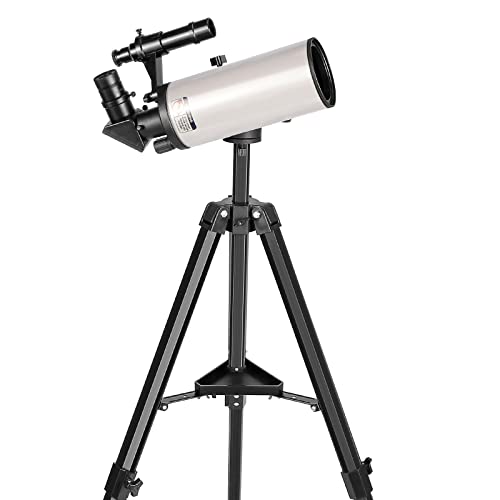
The Mak-cass design of the Sarblue MAK70 telescope provides several benefits, distinguishing it from other telescopes. Firstly, it significantly reduces aberrations, resulting in clear and crisp views. Additionally, the quality fully multi-coated optical components ensure high precision, high reflectivity of the coating, and resistance to oxidation. This telescope provides vivid and vibrant views of terrestrial objects and magnificent views of celestial objects.
The Maksutov-Cassegrain optical design allows for a 1000mm focal length to be folded into a compact 210mm length tube. With a 70mm aperture, this telescope allows a greater amount of light to enter, resulting in higher resolution. Its compact and lightweight design makes it ideal for camping and easy to pack in any backpack for travel.
The Sarblue MAK70 is equipped with a micro-movement tripod, which provides a more precise and comfortable calibration experience. Its perfect combination of quick and slow motion makes it a valuable addition to your telescope. The tripod can be adjusted from 23 inches to 56 inches and supports most available telescope tubes, as well as most DSLR cameras with a dovetail. You can attach the telescope to a field tripod with a 3/8" or 1/4"-20 threaded post.
This telescope comes with a 20mm quality eyepiece, which brings 50X magnification, and a 10mm photographic eyepiece, which brings 100X magnification. It also includes a universal phone mount with a 1.5X Barlow Lens for simple astrophotography. The 5X24 finderscope has an adjustable angle and position, and the aluminum alloy integrated telescope tube provides a stronger texture.
- Mak-cass design reduces aberrations and provides clear and crisp views
- Fully multi-coated optical components ensure high precision and reflectivity
- Compact and lightweight design makes it ideal for camping and travel
- Comes with a micro-movement tripod for more precise calibration
- Adjustable tripod supports most available telescope tubes and DSLR cameras
- Includes a range of accessories for various magnifications and astrophotography
9. Sky-Watcher's Night Sky Tracker: Panoramas & Time-Lapse
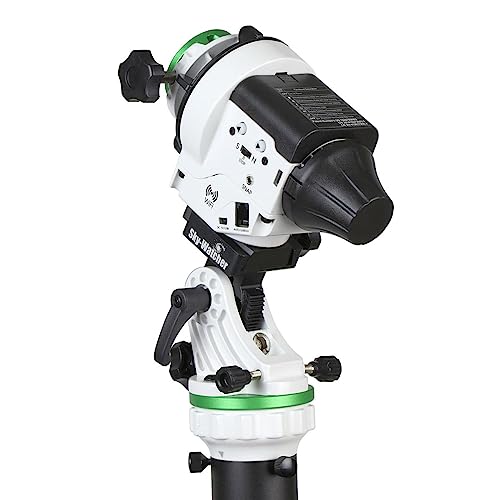
The Portable Nightscape Tracking Platform is a motorized tracking platform that is perfect for capturing incredible details of the Milky Way, eclipses, and other astronomical objects. This unique and modular design allows for integration with existing photographic tripods, making it ideal for wide-field astrophotography, time-lapse video, and even telescopic use. The upgraded Star Adventurer 2i comes with Wi-Fi, allowing for smartphone control using Sky-Watcher’s free SAM Console app. The Deluxe Equatorial base helps position the Star Adventurer 2i at the perfect angle for polar alignment.
The Portable Nightscape Tracking Platform is perfect for astrophotography enthusiasts who want to capture stunning images of the night sky. It is highly versatile and can be used for wide-field astrophotography, time-lapse videos, and even telescopic use. The upgraded Star Adventurer 2i comes with Wi-Fi, making it easier to control using a smartphone. The Deluxe Equatorial base helps position the Star Adventurer 2i at the perfect angle for polar alignment, ensuring that users can capture the best possible images of the night sky.
- Highly versatile and can be used for wide-field astrophotography, time-lapse videos, and telescopic use
- Upgraded with Wi-Fi for smartphone control using the free SAM Console app
- Modular design allows for integration with existing photographic tripods
- Deluxe Equatorial base helps position the Star Adventurer 2i at the perfect angle for polar alignment
10. Gskyer German Tech Telescope: Eq-130 Reflector Scope
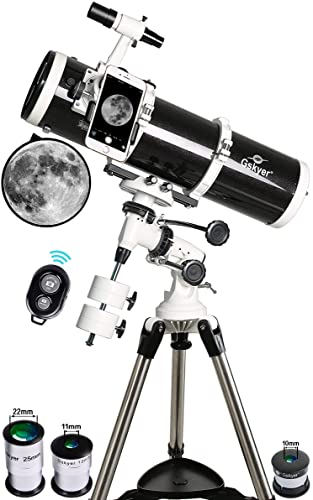
For anyone who wishes to explore the night sky, this reflector telescope is an excellent option. With a 5.1 inch aperture and all-glass optical components, it offers enhanced image brightness and clarity, making it perfect for observing the Moon, planets, galaxies, nebulas, and star clusters. Its short 24 inch long optical tube and fast f/5 focal ratio, along with its toothless focusing base, provide a user-friendly experience for both beginners and advanced astronomers.
The telescope comes with three eyepieces, a 3X Barlow lens, a finderscope, and an adjustable tripod, making it easy to find and observe celestial objects from any viewing position. Additionally, the wireless remote control eliminates the need to download an app and can be paired with any Bluetooth-compatible iPhone or Android device. With the Bluetooth camera remote, users can take pictures or videos and share them with family and friends in real-time.
For added peace of mind, this telescope comes with a 1-year warranty and lifetime maintenance, ensuring its quality and reliability. If you have any questions or concerns about the product or service, the manufacturer provides helpful customer support to ensure your satisfaction.
- 5.1 inch aperture and all-glass optical components provide enhanced image brightness and clarity
- Short 24 inch long optical tube design and fast f/5 focal ratio, along with its toothless focusing base, make it user-friendly for beginners and advanced astronomers
- Comes with three eyepieces, a 3X Barlow lens, a finderscope, and an adjustable tripod, making it easy to find and observe celestial objects
- Wireless remote control eliminates the need for downloading an app and can be paired with any Bluetooth-compatible iPhone or Android device
- Comes with a 1-year warranty and lifetime maintenance
Best Focal Length For Astrophotography FAQs
Can I use a zoom lens for astrophotography and still achieve good results?
Yes, you can use a zoom lens for astrophotography and still achieve good results, but it depends on the specific lens and its specifications. Generally, a zoom lens with a wide aperture and a focal length of at least 200mm would be suitable for capturing clear and detailed images of celestial objects such as stars, galaxies, and nebulas. However, it's important to note that using a zoom lens for astrophotography may have some limitations compared to using a dedicated telescope or prime lens. For instance, the zoom lens may not have the same level of magnification or sharpness as a specialized lens, and it may also be more difficult to track and focus on moving objects in the night sky. Nonetheless, with the right techniques and settings, it's possible to capture stunning astrophotography shots using a zoom lens.
How does the aperture affect the focal length for astrophotography?
The aperture is a crucial factor in astrophotography, as it can significantly impact the focal length of the image. The aperture refers to the opening in the lens that controls the amount of light entering the camera. The size of the aperture is measured in f-stops, which is the ratio of the lens's focal length to the diameter of the aperture.
The wider the aperture, the lower the f-stop number, and the more light enters the camera. This allows for faster shutter speeds and brighter images. However, a wider aperture also reduces the depth of field, which means that the subject may become blurred if it is not in focus.
In astrophotography, a wider aperture is generally preferred, as it allows for more light to enter the camera and capture faint details in the night sky. This also allows for shorter exposure times, which can reduce the amount of time the camera is exposed to the elements, reducing the risk of blurring due to movement.
In summary, a wider aperture can help to increase the focal length in astrophotography by allowing more light to enter the camera, resulting in brighter and more detailed images. However, care must be taken to ensure that the subject is in focus, as the depth of field will be reduced.
How does the focal length affect my astrophotography images?
The focal length of your camera lens plays a crucial role in determining the quality of your astrophotography images. This is because the focal length determines the magnification of the objects you are photographing. A longer focal length will magnify the object more, while a shorter focal length will show a wider field of view.
When it comes to astrophotography, a longer focal length is generally preferred as it allows you to capture more detail in the objects you are photographing. For example, a longer focal length will allow you to capture more detail on the surface of the moon or the rings of Saturn. However, it's important to note that a longer focal length also means that any movement of the camera is magnified, so it's crucial to use a stable tripod and to avoid any vibration.
Overall, understanding how the focal length affects your astrophotography images is key to getting the best possible results. By experimenting with different focal lengths and settings, you can find the perfect combination to capture stunning images of the night sky.
What is the difference between using a wide-angle lens and a telephoto lens for astrophotography?
When it comes to astrophotography, the choice of lens can make a significant difference in the outcome of your images. Two of the most commonly used lenses are wide-angle and telephoto lenses, each with its unique features and advantages.
Wide-angle lenses are typically used for capturing expansive landscapes of the night sky, including the Milky Way and other celestial objects. They have a wider field of view, which allows you to capture more of the sky in a single shot. This makes them ideal for capturing star trails or creating panoramic images of the night sky.
On the other hand, telephoto lenses are better suited for capturing close-up shots of individual objects in the sky, such as planets, stars, or the moon. They have a narrower field of view, which allows you to zoom in on specific objects and capture more detail. They also tend to have a larger aperture, which enables you to shoot at higher shutter speeds and capture sharper images.
Ultimately, the choice of lens depends on what you want to capture and the style of astrophotography you are going for. A wide-angle lens is great for capturing the grandeur of the night sky, while a telephoto lens is ideal for capturing the intricate details of individual objects.
What is the ideal focal length for capturing deep space objects in astrophotography?
The ideal focal length for capturing deep space objects in astrophotography depends on various factors such as the size and distance of the objects, the camera sensor size, and the specific goals of the photographer. However, in general, a focal length between 500mm and 1000mm is considered ideal for astrophotography.
A longer focal length allows for greater magnification and better resolution, which is necessary for capturing faint details in deep space objects such as galaxies, nebulae, and star clusters. However, using a longer focal length requires a sturdy tripod and mount to avoid camera shake and blurring of the image.
It's important to note that the ideal focal length also depends on the camera sensor size. For example, a full-frame camera would require a longer focal length to achieve the same magnification as a camera with a smaller sensor.
Ultimately, the ideal focal length for astrophotography varies depending on the specific objects being captured and the photographer's goals, but a focal length between 500mm and 1000mm is a good starting point.

